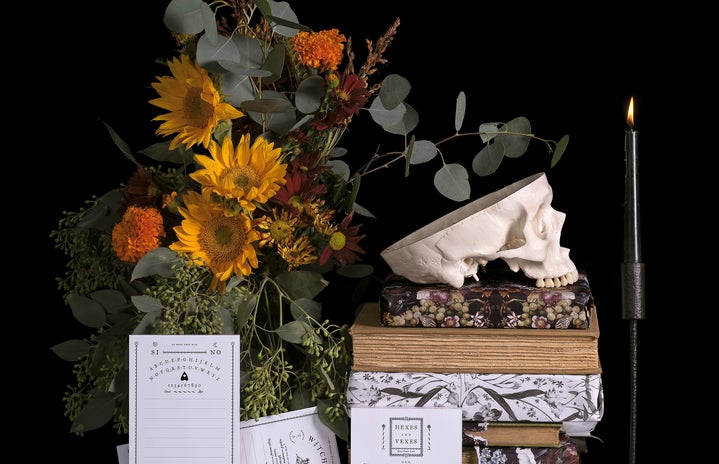Black Magic
She was a white rose in the grey and muddy guts of 17th century Paris. Her expensive dress and sheet white complexion gave her away as aristocracy. The Marquise of Montespan descended from her horse-drawn carriage and entered a run-down house that looked like any other. She was looking for the same thing every woman was looking for: Control.
The house was home to La Voisin. A woman who started off as a fortune-teller to pay the family debts. She attracted many women with some money and in need of a pastime. La Voisin soon started offering what they really wanted: to change their future. These women were often at the mercy of their fathers and husbands. An alchemist, La Voisin sold them arsenic, an undetectable poison nicknamed ‘inheritance powder’. She discreetly performed backstreet abortions on illegitimate pregnancies for these desperate women. Her poisons and reputation for discretion were a powerful combination.
She graduated from selling simple remedies to using infant sacrifice, pigeon’s blood, ground human bones and powders to create her concoctions. She performed spells to make her clients more beautiful, sold magic amulets for protection, and made love potions. Being one of the most beautiful women of the time and a part of the Royal Court, it was the latter that interested our white rose, the Marquise de Montespan.
Power Grab
King Louis XIV, the first absolute ruler of France, made his country the dominant power in Europe. The ‘Sun King’ kept a tight grip on nobles by giving financial rewards to those closest to him. His court was the heart of French politics. The aristocracy scrambled to compete for a place. It was said, “the ladies at the court would have given themselves to the devil for the love of the King.”
That is exactly what Montespan did. In that unassuming house, La Voisin, Montespan and a renegade priest performed a black mass and prayed to the devil in an amatory ritual to manipulate someone to fall in love.
Invited to dinner with the King, Montespan snuck in love potions in his food. Sure enough, he made her his official mistress after a few months in 1667. She gave birth to seven children over the next decade who were officially recognised as legitimate.
Pandora’s Box
Who would have thought a death of natural causes would unearth La Voisin’s dark secrets?
In 1672, Sainte-Croix, an army officer, was found dead. His creditors, rummaging through his belongings, found a small box filled with toad powder, vials with traces of poison, and letters to be read ‘if I die before the Marquise de Brinvilliers’. These letters revealed how his mistress had used arsenic poison to kill her father and brothers to get the money needed to escape her arranged marriage.
Sainte-Croix’s links with high-ranking people close to the King make this case important for the Lieutenant of Police, La Reynie. The Marquise de Brinvilliers failed to escape the investigation by fleeing the country and was extradited back.
She was tortured. 24 pints of water overflowed her throat but refused to reveal any other accomplices. Though, her final words suggested otherwise: “Out of so many guilty people, must I be the only one to be put to death?” An executor sliced open her neck in the Place de la Greve, where her body is burned. With her ashes left to blow throughout Paris, a spectator remarked: “with such evil little spirits in the air, who knows what poisonous humour may overcome us?”
Escalation
3 years after her execution, the mysterious deaths do not stop. The ‘Burning Chamber’ was born: A special tribunal The King set up to investigate this affair,
During an aristocratic party, another fortune-teller-cum-poisoner, Marie La Bosse, very drunk, boasted about how she gained her fortune by selling poison. A lawyer turned her into La Reynie. When questioned, she does not hesitate to name her business rival.
La Reynie arrested La Voisin in March 1679. She was promptly burned alive at the stake for witchcraft in the Place de Greve. But, true to her discretionary style, she did not incriminate her clients.
Her daughter exposed everything, though.
All her clients in Louis XIV’s court were brought to light, Countesses, Duchesses, the head of the Queen’s household, the occasional male poisoner, too. But, most importantly, the worst crimes she revealed were committed by his favourite: the Marquise de Montespan.
Her daughter detailed that Montespan returned to La Voisin, now, The King’s eye was wandering. Accounts testified that Montespan would kill the king if he ever left her. La Voisin hatched a plot. She doused a petition in poison and Montespan would deliver it into the King’s hands. This plan was only foiled as there were too many petitions that day for the King to handle personally.
High Stakes
After these revelations, King Louis dissolved the court fearing the bad publicity. After 5 days it opened again, but the King banned investigation into the state. La Reynie was certain of Montespan’s involvement but fearing the King, did not pursue her.
Louis XIV was an unforgiving leader, fervent Catholic believer, charmer, who could have his pick of any other mistress, yet Montespan was the exception.
The affair implicated 442 suspects. 36 were publicly executed. Many others were killed during the ruthless torture for more information. Many spent their entire lives in prison thanks to the King’s ‘letters of cachet’ which allowed them to be imprisoned without trial. The Burning Chamber was finally dissolved in 1682.
The End
After the birth of her children and unkind years, King Louis no longer favoured Montespan. Younger mistresses took her place, though he allowed her to stay at court. In 1691 she moved to a convent where she died in 1707.
When La Reynie died in 1709, the King burned all documents of the affair. But the lieutenant had left unofficial copies and the legend lives on today.
People accused women of sorcery who went against societal rules. Stories of abortion were spun into webs of devil worship and occult rituals. And guilt was based on testimonies gained by torture.
This affair killed twice as many as the Salem witch trials. It revealed the ruling classes’ perversity, hypocrisy, and their suppression of the truth. It helped fuel discontent that would lead to a revolution a century later.
The affair mixed love, magic, and murder. It cast light on the hidden guts of the rich society. And it cast a dark shadow over the reign of the ‘Sun King.’



